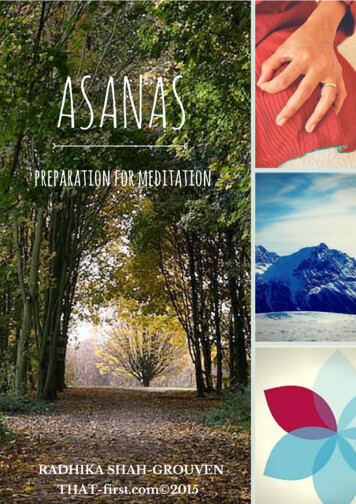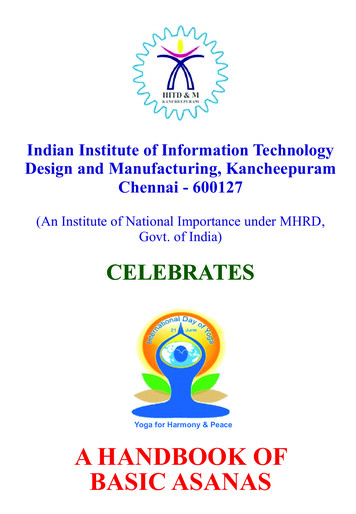
Transcription
ASANASpreparation for meditationRADHIKA SHAH-GROUVENTHAT-first.com 2015
Copyright c 2015 Radhika Shah GrouvenAll Photographs Copyright c 2015 Radhika Shah GrouvenP UBLISHED BY P UBLISHERYou are granted a non-exclusive, perpetual, transferable license to re-use, to reproduce, to copy andto distribute the pdf or part of it for non-commercial purposes provided the relevant text paragraphsremain unmodified. With any distribution of the pdf or any text paragraphs of the latter in any form(on- or offline), you are obliged to attribute it to our website URL that-first.com and to the authorRadhika Shah-Grouven by setting a hyperlink directing to that-first.com and by reference to theauthor. If you wish to transfer this license to a third party you are obliged to make sure that thethird party is subject to the same restrictions. Any other use beyond these restrictions requires priorwritten permission from the author Radhika Shah-Grouven.First printing, March 2015
Contents1Foreword . . . . . . . . . . . . . . . . . . . . . . . . . . . . . . . . . . . . . . . . . . . . . . . . . . . . . . 7AsanasI2Understanding Asana Practice in Yoga Meditation . . . . . . . . . . . . . . . . . 112.1Anatomy behind Static Asanas112.2Dynamic versus Static Asanas122.3Is it necessary to do asanas in Yoga Meditation?122.4How many asanas do we need to do in a Yoga Meditation session?122.5Mastering Asanas: 3 Insider Tips132.6What do I need to practice asanas?142.7Guidelines for Asana Practice143Diaphragmatic Breathing in Meditation . . . . . . . . . . . . . . . . . . . . . . . . . . . 173.1The 3 types of Breathing173.2How Diaphragmatic Breathing works173.3Are you breathing right?183.4Diaphragmatic Breathing and Meditation183.5How to train Diaphragmatic Breathing194Vrikshasana . . . . . . . . . . . . . . . . . . . . . . . . . . . . . . . . . . . . . . . . . . . . . . . . . . 214.1The Supine Tree214.2Vrikshasana: The Standing Tree23Copyright c Radhika Shah Grouven, That-first.com
4.3The Standing Tree: Advanced Version245Bhujangasana - The Cobra . . . . . . . . . . . . . . . . . . . . . . . . . . . . . . . . . . . . . . 275.1Preparation for the Cobra275.2Bhujangasana: The Cobra286Makarasana - The Crocodile Pose . . . . . . . . . . . . . . . . . . . . . . . . . . . . . . . 296.1The Crocodile: Variation 1 for Breath Training296.2The Crocodile Variation 2 for Relaxation307Paschimottanasana - The Posterior Stretch . . . . . . . . . . . . . . . . . . . . . . . 337.1Preparatory Pose 1 for Paschimottanasana337.2Preparatory Pose 2 for Paschimottanasana337.3Paschimottanasana: The Posterior Stretch348Matsyendrasana - The Spinal Twist . . . . . . . . . . . . . . . . . . . . . . . . . . . . . . 358.1Preparatory pose 1 for Matsyendrasana358.2Preparatory pose 2 for Matsyendrasana358.3Matsyendrasana369Sarvangasana - The Shoulderstand . . . . . . . . . . . . . . . . . . . . . . . . . . . . . . 379.1Sarvangasana variation 1:379.2Sarvangasana variation 23810Halasana - The Plough . . . . . . . . . . . . . . . . . . . . . . . . . . . . . . . . . . . . . . . . . 3910.1Preparatory Pose 1: Single Leg Lifts3910.2Preparatory Pose 23910.3Preparatory Pose 34010.4Preparatory Pose 44010.5Preparatory Pose 5: Double Leg Lifts4010.6Preparatory Pose 6: Ardha Halasana, the Half Plough4110.7Halasana: The Plough4111Savasana - The Corpse Pose . . . . . . . . . . . . . . . . . . . . . . . . . . . . . . . . . . . . 4311.1Savasana: The Corpse Pose12Matsyasana - The Fish . . . . . . . . . . . . . . . . . . . . . . . . . . . . . . . . . . . . . . . . . 4512.1Preparatory Pose 1: Leg cradle4512.2Preparatory Pose 24612.3Preparatory Pose 3: Ardha Padmasana4612.4Preparatory Pose 4: Padmasana4712.5Matsyasana: The Supine Fish pose4843
13Dhanurasana - The Bow . . . . . . . . . . . . . . . . . . . . . . . . . . . . . . . . . . . . . . . . 5113.1Preparatory Pose 15113.2Preparatory Pose 25113.3Dhanurasana: The Bow5214Trikonasana - The Triangle . . . . . . . . . . . . . . . . . . . . . . . . . . . . . . . . . . . . . . 5314.1Trikonasana: The Triangle15Shalabhasana - The Locust . . . . . . . . . . . . . . . . . . . . . . . . . . . . . . . . . . . . . 5515.1Preparatory Pose 1 for the Locust5515.2The Locust5616About the Author . . . . . . . . . . . . . . . . . . . . . . . . . . . . . . . . . . . . . . . . . . . . . . 5753
1. ForewordDear Readers,This pdf is about the practices of the Samaya Srividya Tradition. This Tradition is unique inthat, its ancient lineage goes back to over 6000 years. These practices have been handed down inan unbroken lineage from teacher to student. Times have changed considerably and in the last fewyears a lot of information, including teachings and practices of have been made freely availablein the form of books and in internet. Nowadays it seems common to learn techniques from theinternet or from books and even teach these to others without any prior practical experience of thesetechniques.Our Tradition is an Oral Tradition and thus the core teachings and the complementary practicesare handed down through personal instruction and direct experience; not through intellectual studyof books and websites. One of the great modern masters of this Tradition, is the Himalayan sageSwami Rama. I can personally vouch for the fact that these practices are not mixed with those ofother traditions or lineages and a great deal of effort has been made to maintain the authenticity andpurity of these traditional practices.One should remember that practices and teachings without personal guidance are not veryuseful. These teachings and practices have been put together for the benefit of those participating inthe mentoring program with Radhikaji. The mentoring program is a modern term for the traditionalmethod of teachings; it is the Oral Tradition of personal instruction and direct experience. Forothers who read and practice these techniques without personal guidance, caution is advised.Indiscriminate practice of some of these techniques can cause damage to the pranic vehicle,disturbances at subtle mental level or physical issues such as headache, damaged muscles, etc. Theauthor does not accept any liability and you have been advised.I would like to take this opportunity to thank my good friend Krishna Narasimhan for his helpand support in the publication of this pdf. This pdf is an excerpt from a book to be published on thesame subject.Radhika Shah-GrouvenApril, 2015Hofheim/Frankfurt a.M, GermanyCopyright c Radhika Shah Grouven, That-first.com
8Chapter 1. ForewordDedicated to myfirst teacher ,My Mother.Copyright c Radhika Shah Grouven, That-first.com
IAsanas
2. Understanding Asana Practice in Yoga MeditationAsana practice in Yoga Meditation is quite different from that of modern yoga studios. Thisguide to Asana practice is for those participating in Yoga Mentoring with Radhika ShahGrouven.The word asana is a Sanskrit word and is translated as "seat, pose". Our Tradition is a meditativeTradition and asanas were never meant to be dynamic but merely poses with little or no movement.The asanas are not the end of the practice but only an extremely small part of the practice. Staticasanas are not exercises as understood by the conventional sense of the word.2.1Anatomy behind Static AsanasHow can asanas with little or no movement help?The brain and nervous system constantly sends out messages in the form of impulses to thenerve endings controlling the muscles. These impulses are carried by the motor neurons, acting likepostmen delivering messages. A very active neuron might carry 40-50 nerve impulses per secondto its muscle fibres, and a moderately active neuron might carry 10-20 nerve impulses per second.When motor neurons transmit impulses, the muscle fibre contracts, when they do not transmitany nerve impulses the muscle fibre relaxes.This physiological process was discovered by the yogis thousands of years ago and used totrain and gain control of the nervous system. Through experimentation they discovered that theconverse also holds true: When the muscles relax the nerve impulses decreases.So what does one do to make a muscle relax?To relax a muscle requires only 2 simple conditions: Do not move. Be still. Do not fall asleep. Remain conscious.In fact, when muscles do not move at all, the nerve impulses stop completely.A completely relaxed muscle such as in Savasana, the corpse pose, indicates that no nerveimpulses are being carried. In this manner the yogis gain conscious control over the nervous systemand some functions of the body, that science calls involuntary and reflexive.Copyright c Radhika Shah Grouven, That-first.com
12Chapter 2. Understanding Asana Practice in Yoga MeditationA common misconception that still exists among biologists is that muscles continue to receiveinput from motor neurons at rest, however Biofeedback since the 1960’s has proven this to beincorrect.2.2Dynamic versus Static AsanasDue to the dramatic difference in the way they are practiced, dynamic asanas or physical exerciseserves quite a different purpose.The purpose of dynamic asanas is not attaining the state of Yoga. The purpose of dynamicasanas is increasing heart rate, exercising the circulatory and respiratory systems. Many moderninstitutions in the plains of India have integrated asanas in their exercise regime to promotepublic health and fitness. What is good for physical health is not necessarily suitable for YogaMeditation. Dynamic asanas do not calm the nervous system. In fact depending on how they arepracticed dynamic asanas even excite the nervous system. Dynamic asanas are not suitable forYoga Meditation.2.3Is it necessary to do asanas in Yoga Meditation?Yes, correct asana practice is absolutely necessary for those who wish to practice Yoga Meditationbecause asanas:1. Balance the Nervous System: Asanas are an unique system of poses that calm down andbalance the nervous system as a preparation for pranayama (breath and energy practices) aswell as advanced states of meditation.2. Facilitate Diaphragmatic Breathing: Asanas open the chest cavity and strengthen the diaphragm so that diaphragmatic breathing becomes effortless and natural even during deeperstates of meditation when we start losing body awareness.3. Train the correct Meditative Posture: Asanas stretch the muscles so that one can sit comfortably in a meditative pose. Poor posture during meditation will lead to discomfort andpain, which is a great obstacle that will force awareness to return to the body level. Asanasalso strengthen the back for longer meditation sessions. Without a strong back it is almostimpossible to sit in the correct posture for longer sessions. You may use support of the wallin the initial stages but those aspiring to higher states of meditation should have strong backsand erect posture during meditation.4. Sharpen the Concentration like a Laser Beam: Besides the above reasons, one of the mostimportant reasons to practice asanas is learning to train your awareness and focus yourattention like a laser beam. The meditator first learns to withdraw his attention from allworldly objects and bring his attention to his own body, gradually moving to the layer ofbreath and energy, then bringing the awareness slowly to subtler aspects of mind and beyond.The entire process of Yoga Meditation takes the meditator gradually inward through the5 layers of the yogic body. The attention is trained to gradually sharpen its focus like alaser beam from the gross to the subtle, from the large to the small, from the external to theinternal.2.4How many asanas do we need to do in a Yoga Meditation session?A session of asanas should contain asanas that: Stretch the spine Bend backward Bend forward Twist the spineCopyright c Radhika Shah Grouven, That-first.com
2.5 Mastering Asanas: 3 Insider Tips13 Reverse the spine Relax the spineRather than quantity, focus on quality. Spend time on preparatory poses so that you can slowly andgradually perfect the asana. Perfection of an asana is not like that of a circus artiste or acrobat. Thisperfection is not strenuous or contrived; it is natural and effortless.2.5Mastering Asanas: 3 Insider TipsImagine the muscle to be like a rubber band. When you stretch the rubber band it is very elastic.However, once the tension is removed, the rubber band contracts immediately.Everyone remembers the severe muscle cramps after running a race in school or the first day atthe gym. This is because the muscle contracted upon sudden stretching. This rubber band principleis known to science as the myotatic stretch reflex.The rubber band principle also applies when practicing asanas. Use of ropes, chairs or otherprops to suddenly and violently stretch the muscles, leads to contraction of the muscles. This iscounterproductive making asanas strenuous and difficult.Copyright c Radhika Shah Grouven, That-first.com
14Chapter 2. Understanding Asana Practice in Yoga MeditationWith exhalation the muscles in the body relax. With every exhalation relax deeper in to theposture. To make the asanas effortless and easy, stretch slowly and gently; instead of force usegravity to your advantage.To gain mastery in asanas: Stretch slowly; avoid sudden jerky movements Relax deeper into the pose with every exhalation Use gravity to your advantage2.6What do I need to practice asanas? Wear loose comfortable clothing, preferably of natural fibre If your floor is carpeted then you can practice asanas directly on the carpet. If not you mayneed a mat. You do not need to buy expensive Yoga mats. In India one often uses an old woollen blanketor carpet. In south India where it is very warm it is quite common to use a cane mat. Ancient texts such as the Bhagavad Gita 6.11 also mention animal skin. You may find cotton, silk and woollen shawls useful to prepare your meditation seat or tocover yourself during meditation. Some meditators find a dark cotton or woollen hat useful to cover the head and eyes duringmedita
I Asanas 2 Understanding Asana Practice in Yoga Meditation. 11 2.1 Anatomy behind Static Asanas 11 2.2 Dynamic versus Static Asanas 12 2.3 Is it necessary to do asanas in Yoga Meditation? 12 2.4 How many asanas do we need to do in a Yoga Meditation session? 12 2.5 Mastering Asanas: 3 Insider Tips 13 2.6 What do I need to practice asanas? 14











